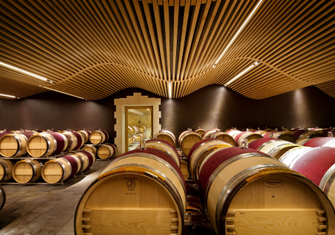Is investing in fine wine worth the money? An easy question to answer and especially in 2020 during a global pandemic – a resounding YES! Fine wine investment has demonstrated its ‘worth’ and benefits to investors in 2020 – delivering stable growth and protecting capital, whilst financial markets and commodities have experienced extreme volatility and lost £billions in value. As the economic conditions have led to the worst UK recession on record, tragically some companies have failed, leaving investors with nothing to show for their hard-earned cash. In contrast, fine wine has demonstrated its worth as an important asset to diversify and strengthen investment portfolios.
How do we measure the Worth of Investing in Fine Wine?
The easy approach to this is to compare fine wine asset performance to other benchmarks to see the value of including fine wine in investment portfolio planning.
The chart sets out the 3.8% growth of the key Liv-ex 100 index versus the FTSE 100’s -21.6% decline during the Covid-19 pandemic year-to-date to the end of October and starkly illustrates fine wine’s ability to protect capital and maintain stable growth during the period. Not only have fine wine trends stayed strong but the market has grown with Liv-ex reporting record and sustained levels of trade by volume and value during the period.
What are the benefits to investing in fine wine?
Asset performance: Fine wine’s key performance characteristic is stable growth which does not directly correlate with volatile financial markets and has historically delivered stronger returns over the long term than equities and other investments.
| Index | YTD to 31.10.2020 | 1 Year to 31.10.2020 | 5 Years to 31.10.2020 |
| Liv-ex 100 | +3.8% | 1.8% | 30.7% |
| FTSE 100 | – 21.6% | -20.2% | -2.5% |
Source: Liv-ex.com – Market Report November 2020
Hedge against recession, inflation and currency devaluation: Despite the current economic conditions the Liv-ex 100 has recorded 3.8% growth to 31st October 2020 YTD and many individual wines significantly more. Examples of these include:
- Dom Perignon P2 1998 – increase 18.97% between May to December 2020
- Chateau Mouton Rothschild 2019 – up 18.04% since en primeur release June 2020 to December 2020
- Dom Perignon David Lynch 2000 – growth 58.56% 1 year to 1 December 2020
- Chateau Lafite Rothschild 2010 – risen 42.43% 5 years to 1 December 2020
- Screaming Eagle Cab. Sauv. 2012 – soared 71.12% 5 years to 1 December 2020
Data source: Liv-ex.com, 2 December 2020
Fine wine’s ability to hold its value during recession and be resistant to the negative impact of inflation makes it a valuable means of strengthening an investment portfolio. As a globally traded commodity it also allows for protection against currency movements.
Tax Efficient investment: The classification of fine wine by HMRC as a ‘wasting asset’ generally means that Capital Gains Tax (‘CGT’) does not apply. Fine wine may become increasingly valuable to investors in light of the likely move by the Chancellor to generate further Tax revenues through CGT to help address the Covid-19 debt burden in the near future. Investors should seek advice from their tax advisor and more information on the Tax Treatment of Fine Wine Investments is available in our special report.
Fine wine held in bonded storage does not attract VAT and Duty payments and as most investment wines remain in bond as ownership is transferred these charges are unlikely to be triggered.
Finite supply and growing demand: Less than 1% of the world’s wine production has the quality, brand recognition and secondary market interest to qualify as investment wine. The fine wine investment market has broadened beyond iconic Bordeaux and Burgundy in recent years to recognise a limited number of additional key wines mainly from Champagne, Italy’s Tuscany and Piedmont regions, California, Spain and Australia.
A finite amount of wine is produced each vintage and this has to satisfy growing global demand. For example, Chateau Petrus produces only 60,000 bottles per annum (equiv. 5,000 cases (12 x 75cl)) and DRC Romanee Conti 5,000 bottles (416 cases). Wealth Managers report an increasing number of their clients now including fine wine investment in their portfolio planning and growing demand supports stable growth over time as individual wines becomes increasingly rare once it starts being drunk. This supply / demand dynamic is an important characteristic of fine wine performance.
Tangible investment: fine wine is a ‘real asset’ and has the added appeal to investors of ‘physically’ illustrating worth – you can see it, touch it and experience it (visit the chateaux and wine estates, enjoy tastings and acquire wines from the same producers to drink) unlike stocks and shares.
Liquidity and flexibility: Fine wine investors enjoy good levels of liquidity primarily due to technological innovations in the last two decades. Liv-ex.com was established in 1999 as a ‘stock exchange’ for fine wine and now has nearly 500 international merchant members posting fine wine pricing information and trading through the platform. This has been a key industry development, providing transparency and efficiency to the market delivering a growing number of channels for investors to buy and exit opportunities for sale. Fine wine investment specialists like Vin-X provide their clients with valuable performance data derived from Liv-ex which facilitates comparisons with other assets and helps them to understand the value of incorporating wine in portfolio planning and to then assist them to create rewarding fine wine collections.
Diversification: As fine wine’s performance does not directly correlate with financial markets, it can be used to diversify, de-risk and strengthen an investment portfolio.

